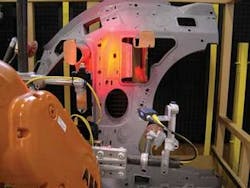Wireless vision systems reduce cable costs
Andy Wilson, Editor
At the International Conference for Vision Guided Robotics, held in October in Novi, MI, Eric Hershberger, a senior engineer with Applied Manufacturing Technologies (AMT; Orion, MI, USA; www.appliedmfg.com) described a prototype vision-based robotics system based on wireless technology (see figure). Deployed at a large automotive manufacturer, the system uses off-the-shelf cameras and wireless routers to allow the automotive company to evaluate the benefits of the technology in rack picking and placement applications.
“In 10 vision-guided robotics workcells,” says Hershberger, “the automotive company was spending over $30,000 on replacement camera and computer cables approximately every six months!” To reduce this cost, the system developed by AMT uses a Gigabit Ethernet camera from DALSA (Waterloo, ON, Canada; www.dalsa.com) coupled to a $200 wireless router from Linksys (Irvine, CA, USA; www.linksys.com). With software development and hardware costs, the customer will be able to see an ROI in less than a year, according to Hershberger.
“Because the camera is directly interfaced to the wireless router,” says Hershberger, “inexpensive Gigabit Ethernet cables can be used. Furthermore, because image data is then wirelessly transmitted to a Wireless-N PCI adapter, also from Linksys, any high-flex cables between the camera and computer are eliminated.”
The access port built into the dual-band Wireless-N router uses dual-band Wireless-N networking technology. Compatible with Wireless-G, A, and B equipment, the Wireless-N standard is still an IEEE 802.11n draft protocol but is expected to be ratified by December 2009. Since the router can operate in both the 2.4- and 5-GHz radio bands at the same time, it effectively doubles the available wireless bandwidth of existing standards, allowing images at rates as high as 600 MBits/s to be transmitted to the host PC. “However,” says Hershberger, “since the application only required images to be transmitted once every 37 seconds, this was not a limiting factor.”
“One of the problems associated with older wireless networking has been the number of networks that are associated with each specific frequency band,” Hershberger says. “As many consumers will attest, using A, G, and B equipment, many local networks can be accessed on the same frequency, creating potential interference hazards. Because the Wireless-N standard is still unapproved, however, very few systems have yet to be deployed and, if they are, it remains to be seen what interference effects will occur.
“Luckily,” says Hershberger, “products such as the wireless router from Linksys also feature four Gigabit Ethernet ports. Thus, if any interference effects should occur in future, the system can be hardwired with Gigabit Ethernet cables.” So far, he says, there have been no such problems.
After images are transmitted to the PC, Microsoft’s Visual Studio2005 was used in conjunction with VisionPro software from Cognex (Natick, MA, USA; www.cognex.com) to develop the rack picking and placement application. Because VisionPro’s vision toolkit supports Visual Basic, C#, and managed C++, the entire application could be programmed within Visual Studio 2005 using just six lines of Visual Basic script.
To perform high-precision guidance, it was necessary to eliminate any discrepancies between the position of the robot, the robot tool control point (TCP), and the fixture alignment and then to transparently compensate for any errors. To accomplish this, Hershberger used the DynaCal system from Dynalog (Bloomfield Hills, MI, USA; www.dynalog-us.com). This system, which incorporates an optomechanical sensor attached to a PC, is used to compensate for robot manufacturing deviations for which the robot controller cannot compensate and thus increase the positional accuracy of robot placement to within 0.5 mm.

